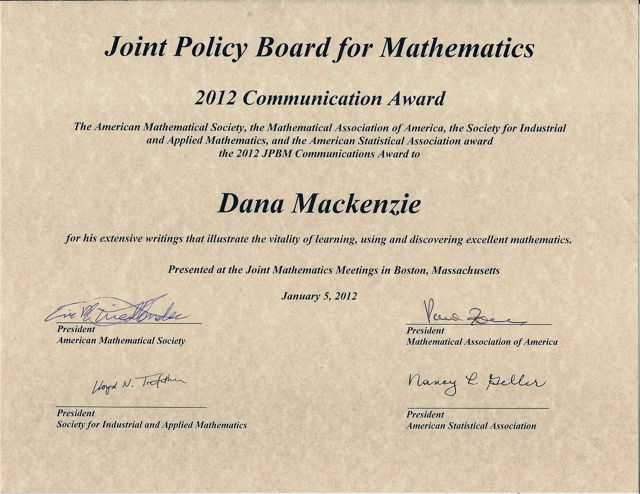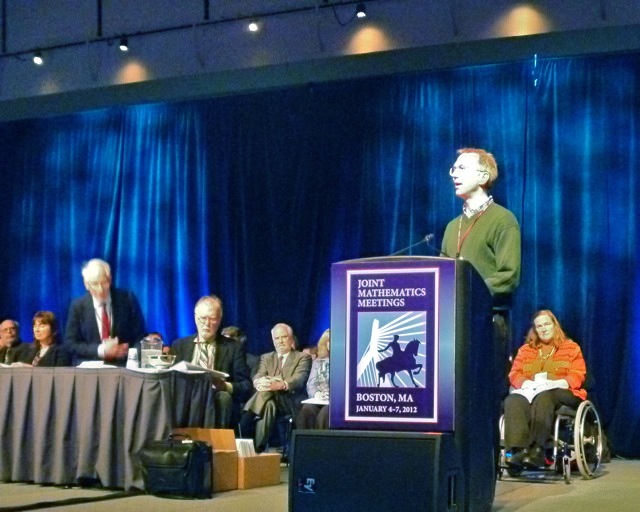So you all must be wondering, “Why were you, a chess blogger living in the San Francisco Bay area, not at the Northern California International chess tournament last week?”
Unfortunately, this tournament always seems to conflict with the Joint Mathematics Meetings, the biggest annual math meeting of the year. You’d think that the organize, Arun Sharma, would know better, because he himself is a mathematician! Arun, please don’t schedule the International on January 9 to 12 next year, okay?
Anyway, I went to Boston last week to socialize, network, learn some mathematics … and oh, by the way, collect a prize. I received the 2012 Joint Policy Board for Mathematics Communication Award, which is just about the only award in the world for math journalism.
The best thing about winning an award like this is that you get to go up on a stage with some of the superstars who have won other awards. People like Bill Thurston, Ivo Babuska, Michael Aschbacher, Joseph Dauben. Well, these names probably don’t mean anything to you, but to me they are legends. Bill Thurston formulated the Geometrization Conjecture, which led to the proof of the Poincare Conjecture, which was Science magazine’s 2006 Breakthrough of the Year, which I wrote about in a cover article. Babuska was a pioneer in the field of finite elements, without which we would still probably all be riding in propeller planes. Aschbacher proved some of the main results in the classification of finite simple groups. Dauben is the world’s leading expert in ancient Chinese mathematics.
Here I am accepting the Communication Award. (Thanks to Frank Morgan for the photo.)
By the way, one thing I have not quite been able to figure out is whether the name of the prize I received is the Communications Award or the Communication Award. If you look very closely, you’ll see that the certificate says both! Because “Communication” is in larger type, I’ll assume that is the correct name.
While I was at the meeting, I compiled a list of “10 Signs That You’re At a Mathematics Conference.” Most of these are real things that I saw or heard last week. A few are jokes. Some are both! I will leave it up to you to figure out which are which.
10 Signs That You Are At a Math Conference
1. Conversation overheard at breakfast: “Bayes has taken over the universe.”
2. Message board has lots of messages with pigs stamped on them.
3. Cars with amusing bumper stickers. (Honk If You Believe the Riemann Hypothesis; If You Can Solve This Equation, You’re Too Close.)
4. Lots of people with beards. Often accompanied by bald spot and/or vacant facial expression.
5. The quietest spot is the press room. Occasional passersby think the “Press Room” sign is a gag. (“You mean they have reporters here?”)
6. People wearing herringbone tweed jackets. Note: This one is a sign both that you are at a math meeting AND that you have been sent back 50 years by a time machine. Mathematicians in herringbone tweed jackets are now as extinct as the passenger pigeon.
7. Colored dots on name badges.
8. Invited speaker juggles balls on the stage before his lecture — and during.
9. Speaker writes “1/2 + 1/3 = 2/5” and nobody laughs.
A. Speaker writes “(a+b)² = a² + b² (The Freshman’s Dream)” and everybody laughs.
B. Speaker rounds the force of gravity up to infinity.
C. You go to a poetry reading and a proposition breaks out — followed, of course, by a demonstration.
D. You go to an art exhibit and the most influential artists (by far) are M.C. Escher and Albrecht Durer.
E. Napkins contain more equations than food stains.
F. Largest crowd turns up for the debate between e and π.
10. Your coffee cup is homeomorphic to a Klein bottle.
Explanations available on request. 😎





{ 5 comments… read them below or add one }
So can I assume the 10 in “10 Signs That You Are At a Math Conference” is written in hexadecimal notation?
Ding, ding, ding! We have a winner!
Explanations please on 9 and A. Pretty please?
Glad to oblige. As computer geeks like Mike know, computers often do arithmetic internally using hexadecimal (base-16) notation. “A” denotes 10, “B” denotes 11, “C” denotes 12, “D” denotes 13, “E” denotes 14, and “F” denotes 15. Sometimes you’ll see a serial number or an activation code that has the letters A through F (but no later letters) mixed in with the numerals 0 through 9 — it’s because the computer considers them all to be hexadecimal numerals.
So the point of my joke was that only math geeks (or computer geeks, but that’s a sort of subspecies of math geeks) would count in base 16… and that’s how you know you’re at a math conference.
Actually computers only do arithmetic internally using binary (base-2) “notation”. It’s debatable whether you could even call the bits in your CPU’s cache notation. Hex (base-16) is something computer geeks use, but not computers. I think it’s because the standard useful unit of data is a byte: 1 byte = 8 bits = 2^8 or 256 possible values. But another way to write 256 is 16×16, which means that you can write the number represented by a byte with a 2-digit hex value instead of an 8-digit binary value (256 decimal = 11111111 binary = FF hex).
In C code, you have to prefix hex numbers with “0x” or the compiler will not treat them correctly. It would have been too much of a giveaway for Dana to number his list 0x01, 0x02, … But with that in mind, here’s an old hex joke:
3×15=45
2×15=30
1×15=15
0x15=21